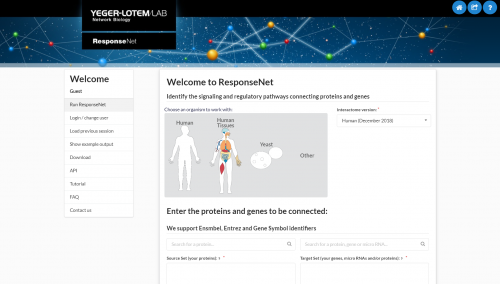
ResponseNet v.3 is an enhanced version of ResponseNet, a webserver that is designed to highlight signaling and regulatory pathways connecting user-defined proteins and genes by using the ResponseNet network optimization approach (https://netbio.bgu.ac.il/respnet). Users run ResponseNet by defining source and target sets of proteins, genes and/or microRNAs, and by specifying a molecular interaction network (interactome). The output of ResponseNet is a sparse, high-probability interactome subnetwork that connects the two sets, thereby revealing additional molecules and interactions that are involved in the studied condition. In recent years, massive efforts were invested in profiling the transcriptomes of human tissues, enabling the inference of human tissue interactomes. ResponseNet v.3 expands ResponseNet2.0 by harnessing ~11,600 RNA-sequenced human tissue profiles made available by the Genotype-Tissue Expression (GTEx) consortium, to support context-specific analysis of 44 human tissues. Thus, ResponseNet v.3 allows users to illuminate the signaling and regulatory pathways potentially active in the context of a specific tissue, and to compare them with active pathways in other tissues. In the era of precision medicine, such analyses open the door for tissue- and patient-specific analyses of pathways and diseases.
Publications
-
ResponseNet v.3: Revealing signaling and regulatory pathways connecting your proteins and genes across human tissues
Nucleic Acids Research, In Press 2019. doi:https://doi.org/10.1093/nar/gkz421 -
ResponseNet2.0: revealing signaling and regulatory pathways connecting your proteins and genes--now with human data.
Nucleic Acids Research 2013 41:W1:W198-W203 -
ResponseNet: revealing signaling and regulatory networks linking genetic and transcriptomic screening data
Nucleic Acids Research 2011 39:W1:W424-9. doi:https://doi.org/10.1093/nar/gkr359 -
Bridging high-throughput genetic and transcriptional data reveals cellular responses to alpha-synuclein toxicity.
Nature Genetics 2009 41:316-323

